
Original Link: https://www.anandtech.com/show/1920
AMD Athlon 64 FX-60: A Dual-Core farewell to Socket-939
by Anand Lal Shimpi on January 9, 2006 11:59 PM EST- Posted in
- CPUs
AMD's Socket-939 has been the platform of choice almost immediately after its introduction, so it is fitting that the last Socket-939 processor to be released would be the Athlon 64 FX-60.
After today's launch of the FX-60, there will be no faster Socket-939 CPUs produced. Instead, everything else will be Socket-AM2 (the new name for Socket-M2). Next quarter, AMD will launch their Socket-AM2 platform along with AM2 versions of the Athlon 64, Athlon 64 X2 and the FX-62. Given that the AM2 platform adds DDR2 support, it is entirely feasible that the Athlon 64 FX-62 won't receive a clock speed bump over the FX-60 and just use the higher bandwidth memory as justification for the higher model number.
Although we've generally shied away from recommending AMD's FX line of processors, we can't help but be a little excited about the FX-60. When AMD introduced their X2 line of dual-core processors, the FX series remained single core, but maintained a fairly high clock speed. AMD even went as far as to release the FX-57, clocked a full 400MHz higher than the fastest X2. With the FX-60, that trend is over; from this day forward, all members of the FX series of processors are now dual core. They are still sold under the Athlon 64 FX brand, despite being dual core chips.
Our excitement over the Athlon 64 FX-60 isn't really about its performance, although at 2.6GHz it is quite stellar; rather, it is more of an excitement out of principle. We've favored and recommended dual core processors to power users as soon as they were available, even though dual core processors were generally far slower at single-threaded applications than their equivalently priced single core alternatives. With the FX-60, at least at the high end, the same is no longer true.
The fastest single core AMD processor is still the Athlon 64 FX-57 running at 2.8GHz, which AMD will continue to sell alongside the FX-60. But with the clock speed gap between the 2.6GHz dual core FX-60 and the 2.8GHz single core FX-57 a meager 7.6%, you can effectively go to one CPU and get the best single-threaded and multithreaded performance. Remember that the best applications that scale with clock speed generally give you a 50% return on every 100% increase in clock speed, so in most of the single-threaded cases, the FX-57's performance advantage will be in the 0 - 4% range. But on the flip side, the fact that the FX-60 is a dual core processor will buy it a lot in multithreaded applications.
As with all FX series processors, the FX-60 debuts at $1031 in quantities of 1000, so you can expect street pricing to be at or around that number. The FX-57 will drop to $827 mark as it will co-exist with the FX-60.
The FX-60 is really just a multiplier unlocked 2.6GHz Athlon 64 X2. It is still a 90nm processor and there are no architectural changes that we've been made aware of or have been able to find on our own. We stress the point that it is still a 90nm chip because of the fact that its closest competitor, the Pentium Extreme Edition 955, just debuted on Intel's 65nm process. Because Intel is on a smaller manufacturing process, they can cram more transistors into a smaller space. So although the Pentium EE 955 is a 376-million transistor chip, they only take up 162 mm2 of space. The Athlon 64 FX-60 by comparison is a 233-million transistor chip, but its die is a larger 199 mm2. The move to 65nm for AMD should cut the die size roughly in half assuming no architectural changes, but until then, Intel will at least have the manufacturing advantage.
You shouldn't, however, assume that the smaller, cooler running manufacturing process will result in a power advantage for Intel. The problem is that those 376 million transistors are used to build a beast of a chip with a 31-stage pipeline, so power consumption is still actually higher on the Extreme Edition than on AMD's fastest dual core:
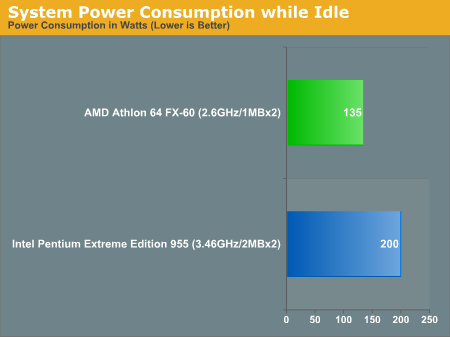
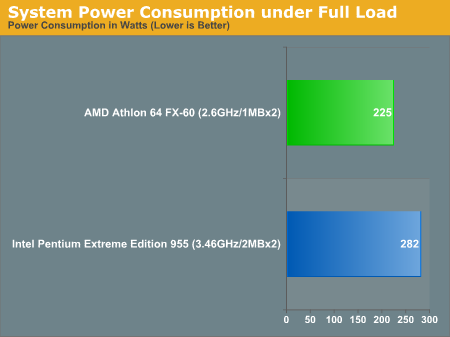
The Test
| CPU: | AMD Athlon 64 X2 4800+ (2.4GHz/1MBx2) AMD Athlon 64 X2 3800+ (2.0GHz/512KBx2) AMD Athlon 64 FX-57 (2.8GHz/1MB) AMD Athlon 64 FX-60 (2.6GHz/1MBx2) Intel Pentium Extreme Edition 955 (3.46GHz/2MBx2) Intel Pentium Extreme Edition 840 (3.2GHz/1MBx2) Intel Pentium D 820 (2.8GHz/1MBx2) |
| Motherboard: | ASUS A8N-SLI Deluxe Intel BadAxe 975X |
| Motherboard BIOS: | ASUS: Version 1013 Dated 08/10/2005 |
| Chipset: | NVIDIA nForce4 SLI Intel 975X |
| Chipset Drivers: | nForce4 6.70 Intel 7.0.0.1020 |
| Memory: | OCZ PC3500 DDR 2-2-2-7 DDR2-667 5-5-5-15 |
| Video Card: | ATI Radeon X1800 XT |
| Video Drivers: | ATI Catalyst 5.13 |
| Desktop Resolution: | 1280 x 1024 - 32-bit @ 60Hz |
| OS: | Windows XP Professional SP2 |
Overall Performance using Winstone 2004
Business Winstone 2004
Business Winstone 2004 tests the following applications in various usage scenarios:
. Microsoft Access 2002
. Microsoft Excel 2002
. Microsoft FrontPage 2002
. Microsoft Outlook 2002
. Microsoft PowerPoint 2002
. Microsoft Project 2002
. Microsoft Word 2002
. Norton AntiVirus Professional Edition 2003
. WinZip 8.1
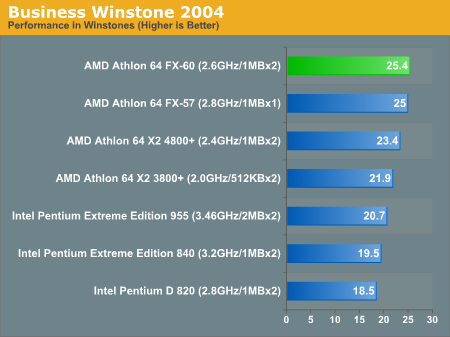
Multimedia Content Creation Winstone 2004
Multimedia Content Creation Winstone 2004 tests the following applications in various usage scenarios:
. Adobe® Photoshop® 7.0.1All chips were tested with Lightwave set to spawn 4 threads.
. Adobe® Premiere® 6.50
. Macromedia® Director MX 9.0
. Macromedia® Dreamweaver MX 6.1
. Microsoft® Windows MediaTM Encoder 9 Version 9.00.00.2980
. NewTek's LightWave® 3D 7.5b
. SteinbergTM WaveLabTM 4.0f
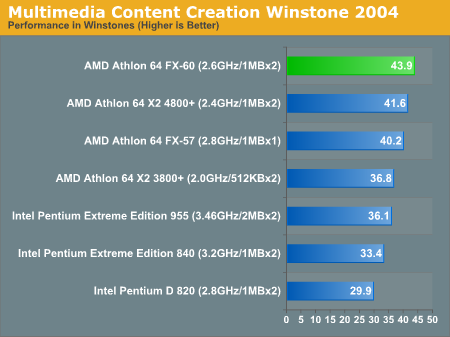
Overall Performance using SYSMark 2004
Office Productivity SYSMark 2004
SYSMark's Office Productivity suite consists of three tests, the first of which is the Communication test. The Communication test consists of the following:
"The user receives an email in Outlook 2002 that contains a collection of documents in a zip file. The user reviews his email and updates his calendar while VirusScan 7.0 scans the system. The corporate web site is viewed in Internet Explorer 6.0. Finally, Internet Explorer is used to look at samples of the web pages and documents created during the scenario."The next test is Document Creation performance:
"The user edits the document using Word 2002. He transcribes an audio file into a document using Dragon NaturallySpeaking 6. Once the document has all the necessary pieces in place, the user changes it into a portable format for easy and secure distribution using Acrobat 5.0.5. The user creates a marketing presentation in PowerPoint 2002 and adds elements to a slide show template."The final test in our Office Productivity suite is Data Analysis, which BAPCo describes as:
"The user opens a database using Access 2002 and runs some queries. A collection of documents are archived using WinZip 8.1. The queries' results are imported into a spreadsheet using Excel 2002 and are used to generate graphical charts."
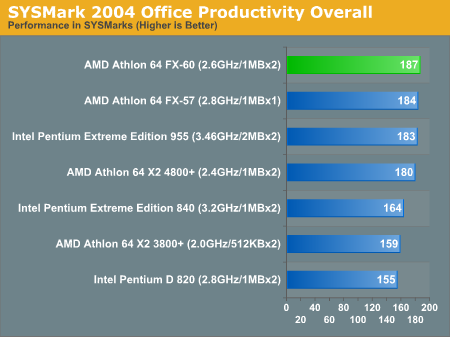
ICC SYSMark 2004
The first category that we will deal with is 3D Content Creation. The tests that make up this benchmark are described below:
"The user renders a 3D model to a bitmap using 3ds max 5.1, while preparing web pages in Dreamweaver MX. Then the user renders a 3D animation in a vector graphics format."Next, we have 2D Content Creation performance:
"The user uses Premiere 6.5 to create a movie from several raw input movie cuts and sound cuts and starts exporting it. While waiting on this operation, the user imports the rendered image into Photoshop 7.01, modifies it and saves the results. Once the movie is assembled, the user edits it and creates special effects using After Effects 5.5."The Internet Content Creation suite is rounded up with a Web Publishing performance test:
"The user extracts content from an archive using WinZip 8.1. Meanwhile, he uses Flash MX to open the exported 3D vector graphics file. He modifies it by including other pictures and optimizes it for faster animation. The final movie with the special effects is then compressed using Windows Media Encoder 9 series in a format that can be broadcast over broadband Internet. The web site is given the final touches in Dreamweaver MX and the system is scanned by VirusScan 7.0."
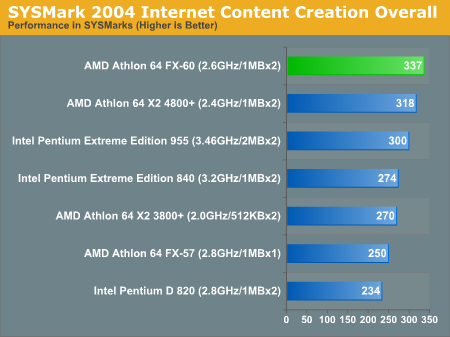
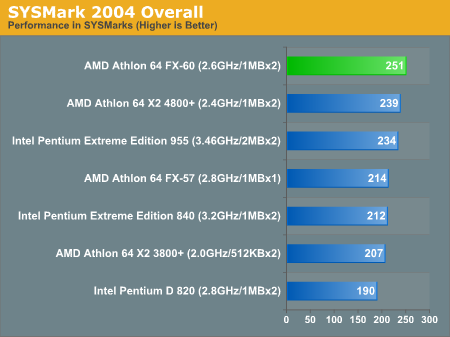
Overall Performance using WorldBench 5
Our final set of overall system performance tests come from WorldBench 5, which is a pretty good tool for looking at older application performance as well as single-threaded performance.

3D Rendering Performance using 3dsmax 7
Once again, we're using an updated version of the SPECapc 3dsmax test for version 7 of the application. The scenes being rendered haven't actually changed, but the reference numbers used to compute the composite scores have, so these scores aren't directly comparable to results from earlier SPECapc tests.
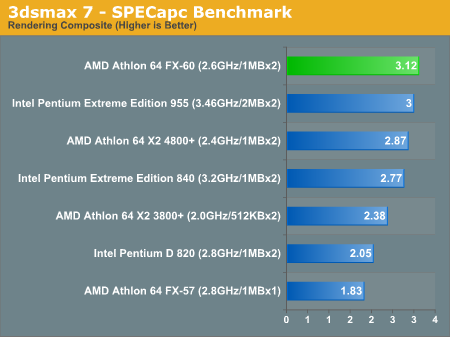
Media Encoding Performance using DVD Shrink, WME9, Quicktime and iTunes
First up is DVD Shrink 3.2.0.15. Our test was simple - we took a copy of Star Wars Episode VI and ripped the full DVD to the hard drive without compression, effectively giving us an exact copy of the disc on the hard drive. Then, using the copy of the DVD on the hard drive (to eliminate any DVD drive bottlenecks), we performed a DVD shrink operation to shrink the movie to fit on a single 4.5GB DVD disc. All of the options were left on their defaults, so the test ends up being pretty easy to run and reproduce. The scores reported are DVD encoding times in minutes, with lower numbers meaning better performance.
The DVD Shrink test is quite important as DVD Shrink is quite possibly one of the easiest tools to rip a DVD. The easier a tool is to use, the more likely it's going to be used, and arguably the more important performance using it happens to be.
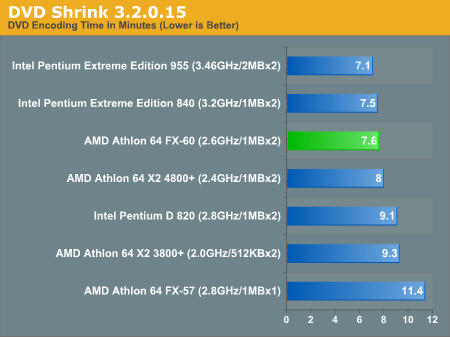
Moving on, we have our Windows Media Encoder 9 test, which uses the advanced profile settings for video encoding. We left all settings at their defaults and just proceeded with a MPEG-2 to WMV-HD conversion. The values reported are in frames per second, with higher numbers being better.

Next up, we have Quicktime Pro 7.0.3 and we perform a MPEG-2 to H.264 encoding task. All of the settings are left at their defaults, with the exception that we optimize the output file for download with a 256kbps data rate while leaving the resolution untouched. We also adjust the video options to optimize for the best quality. We report the transcoding time in minutes, with lower values being better.
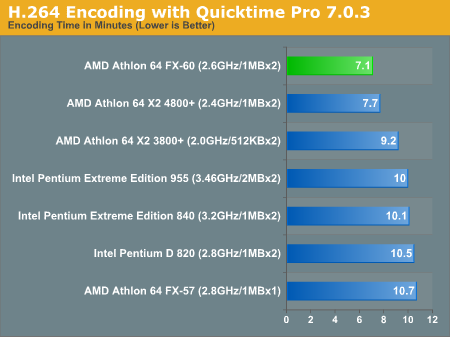
Finally, we have a MP3 encoding test using iTunes 6.0.1.3. For this test, we simply took a 304MB wav file and converted it to a 192kbps MP3 file, measuring the encode time in seconds. The only iTunes option that we changed was to prevent the playback of the song while encoding.
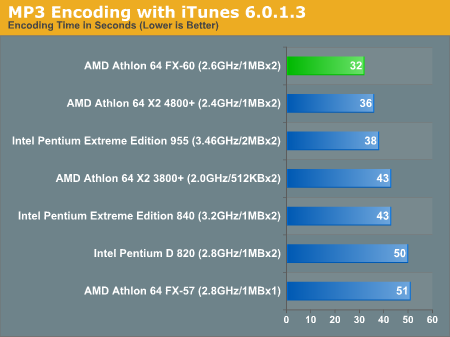
Gaming Performance using Battlefield 2, Call of Duty 2 and Quake 4
Gaming performance is pretty respectable for the Pentium EE 955, with the chip being quite competitive with AMD's Athlon 64 X2 4800+.
The most interesting thing we found is that even with a high end GPU like the Radeon X1800 XT, a number of games are still quite GPU limited even at 1024x768, which is why you don't see F.E.A.R. and Splinter Cell: CT here. Even some of the games that we did required us to turn down some of the detail settings to start to stress the CPUs.
The pendulum often swings between games being CPU and GPU limited, and it seems that with the latest generation of games, we are definitely more GPU limited.
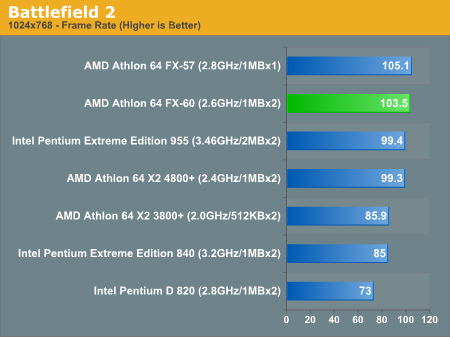
We should also mention that we had to re-run our AMD numbers in this test since the last review as we were seeing sub-par AMD performance. A clean install and re-run of the numbers yielded the results that you see today; the Intel numbers didn't change.
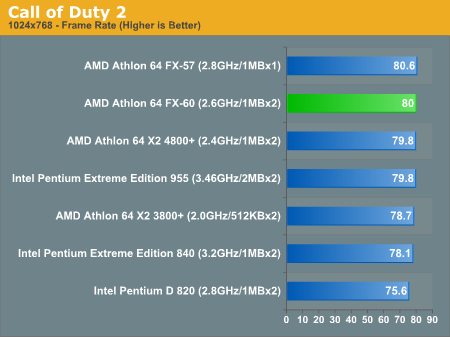
We did run with SMP support disabled, as we found in our last article that the game gave us higher frame rates without it enabled.
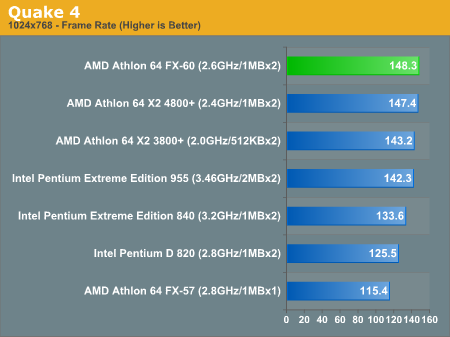
Final Words
The prospect of dual core usually meant that you had to give up some single-threaded performance, but with the Athlon 64 FX-60, that tradeoff is no longer true. While it's still not clocked as high as the fastest single core processor, it is extremely close. It's close enough that the difference in clock speed makes single-threaded performance a non-issue.
The fact that the FX-60 and FX-57 are almost at a clock speed parity is important because it does mean that we are getting beyond the inflection point of the dual core/single core transition. The high end dual core chips are all but caught up to the high end single core chips of just six months ago. Intel still has a little way to go before the same is true for them, but with the FX-60, it does hold true for AMD.
Unfortunately, since the FX-60 is still built on the same 90nm Toledo core as the previous X2 processors, overclocking headroom is not that great. With a retail AMD heatsink/fan, the best that we could do is 2.8GHz at 1.40V. With more exotic cooling, you could probably manage better, but stepping up the voltage all the way up to 1.50V wouldn't yield a 3GHz overclock on air.
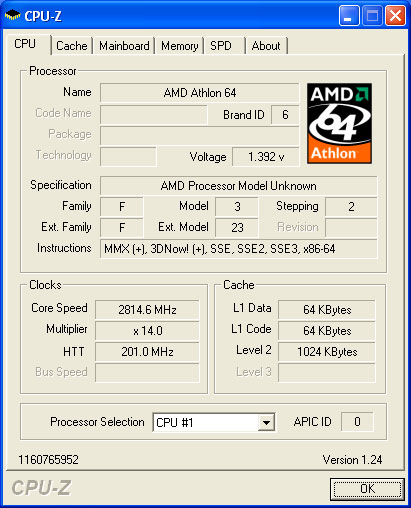
Then there's the issue of AMD's upcoming Socket-AM2; due out in another few months, you obviously won't be able to use any Socket-939 processors in the new motherboards and there will be no upgrade path beyond the FX-60 for current 939 owners. So, our recommendation would be to stay away from the FX-60 unless you absolutely have to build the world's fastest system today.
If the latter is true, then you can't go wrong with the FX-60; if not, however, you'll be better off waiting for AM2.







